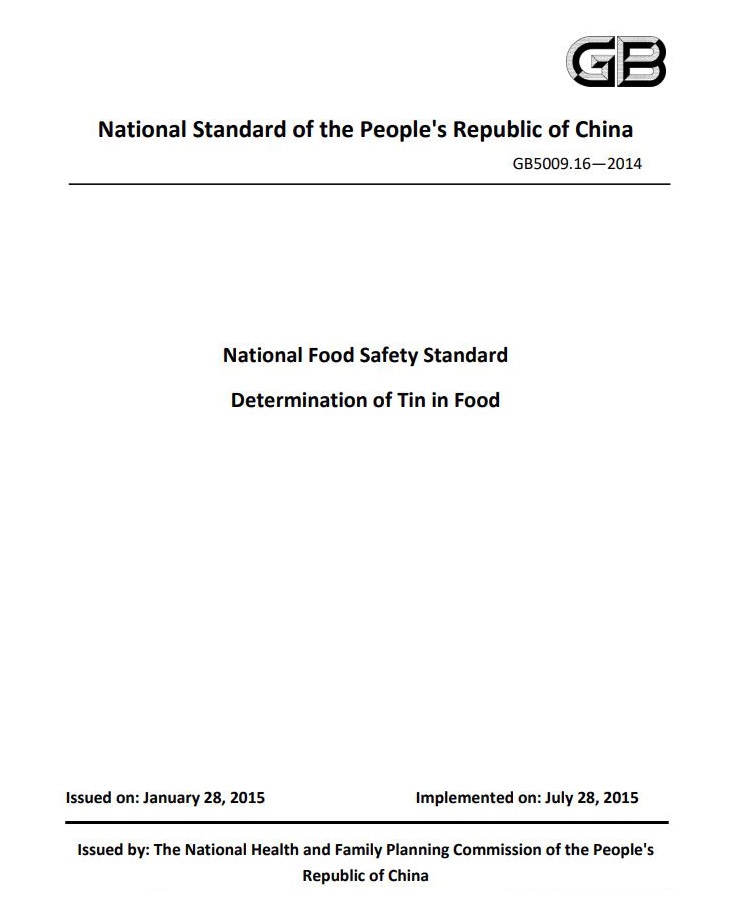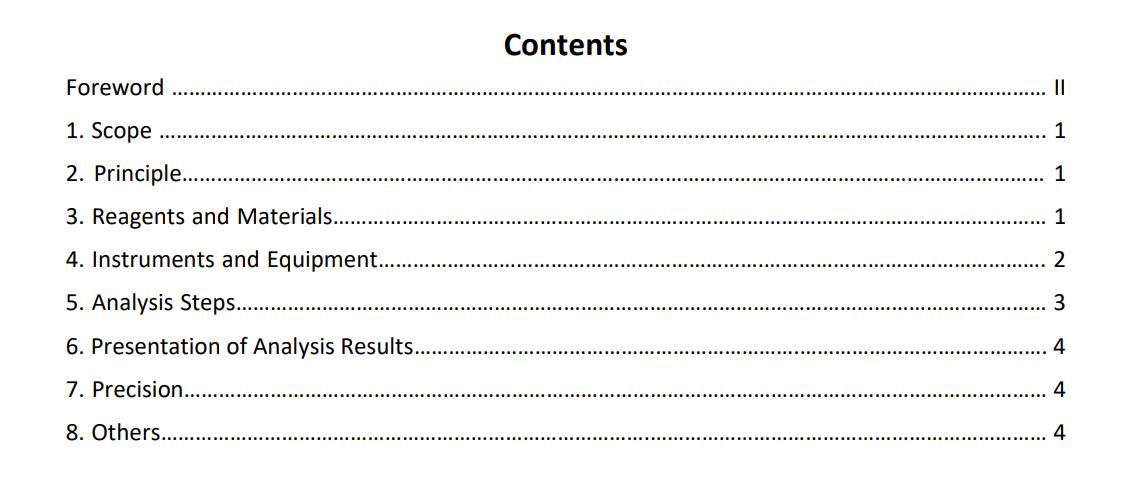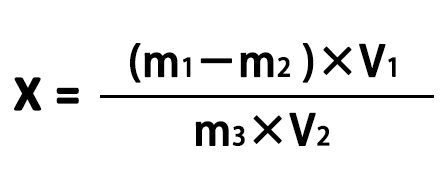Determination of Tin in Food 2 - National Food Safety Standard
Publish Date: 2015-01-28
Implement Date: 2015-07-28
Issued by: The National Health and Family Planning Commission of the People's Republic of China
Standard Status: currently valid
This is the National Standard of the People's Republic of China, GB5009-16-2014, Determination of Tin in Food, there are two analytical methods. The method 1: hydride atomic fluorescence spectrometry ( AFS ) . The method 2: benzfluorenone colorimetry. This article describes the method 2.
The method 2 of this standard specifies benzfluorenone colorimetry for the determination of tin in food. Suitable for determination of tin in food.
The English version of this standard is translated from the Chinese original GB5009.16-2014. In case of discrepancies in the translated version, the original Chinese standard GB5009.16-2014 (Chinese version) shall prevail. This translated version can provide reference for food production enterprises.
Standard Text of GB5009.16-2014
A. Standard Cover of GB5009.16-2014

B. Table of Contents

C. Standard Preface of GB5009.16-2014
Foreword
—— Modified the calculation formula.
—— Modified the detection limit of the method;
—— The quantification limit of method has been increased;
—— Modified the description of the instrument measurement part;
—— Added the sample preparation method for canned food;
—— Modified the preparation of standard solutions;
—— The name of the standard is changed to "National Food Safety Standard, Determination of Tin in Food";
Compared with GB/T 5009.16-2003, the main changes of this standard are as follows:
This standard replaces GB/T 5009.16-2003 "Determination of Tin in Foods".
D. Standard Content of GB5009.16-2014
National Food Safety Standard
Determination of Tin in Food
1. Scope
This standard specifies the determination methods of hydride atomic fluorescence spectrometry and benzfluorenone colorimetry of tin in food. This standard is applicable to the determination of tin in canned solid food, canned beverage, canned jam, canned infant formula and supplementary food.
The Method 2: Benzfluorenone Colorimetry
2. Principle
After the sample is digested, the tetravalent tin ion and phenylfluorenone form a slightly soluble orange-red complex in the weakly acidic solution, which is compared with the solutions of standard series in the presence of protective colloid for quantitative analysis.
3. Reagents and Materials
Note: Unless otherwise specified, the reagents used in this method are all analytical reagent (AR) and the water is the water of grade 3, specified in GB/T 6682.
3.1 Reagents
3.1.1 Tartaric acid (C4H4O6H2).
3.1.2 Ascorbic acid (C6H8O6).
……
3.2 Reagent Preparation
3.2.1 Tartaric acid solution (100g/L): Weigh 100g of tartaric acid and dissolve it in 1L of water.
3.2.2 Ascorbic acid solution (10.0g/L): Weigh 10.0g of ascorbic acid and dissolve it in 1L of water, and prepare it for immediate use.
……
3.3 Standard Chemicals
It is metal tin (Sn) standard with 99.99% purity. It must be a reference material (RM) certified by the state and granted a reference material certificate.
3.4 Preparation of standard solutions
3.4.1 Tin standard solution (1.0mg/mL): Accurately weigh 0.1g (accurate to 0.0001g) metal tin standard and place it in a small beaker. ……
4. Instruments and Equipment
4.1 Spectrophotometer.
4.2 Electronic balance: the sensing capacity is 0.1mg and 1mg.
5. Analysis Steps
5.1 Sample Preparation
5.1 1 Sample Digestion: Weigh 1.0g ~ 5.0g of sample into a conical flask, add 20.0mL of nitric acid + perchloric acid mixed solution (4+1). ……
5.2 Preparation of Standard Curve
Draw 0.00mL, 0.20mL, 0.40mL, 0.60mL, 0.80mL, 1.00mL standard tin solution (equivalent to 0.00μg, 2.00μg, 4.00μg, 6.00μg, 8.00μg, 10.00μg tin), and put them separately in 25mL colorimetric tubes. ……
5.3 Determination of Sample Solution
Use a 2cm cuvette to adjust the zero point with a standard series solution zero tube, measure the absorbance of the reagent blank solution and the sample solution at a wavelength of 490nm, and compare the obtained absorbance value with the standard curve or substitute it into a regression equation to calculate the content.
6. Presentation of Analysis Results
The tin content in the sample is calculated according to formula (2):
 ------------ (2)
------------ (2)
In formula (2):
X —— the content of tin in the sample, in milligrams per kilogram or milligrams per liter (mg/kg or mg/L);
……
7. Precision
The absolute difference between the results of two independent determinations obtained under repeatability conditions shall not exceed 10% of the arithmetic mean.
8. Others
When the sampling amount is 1.0g, the limit of quantification of this method is 2.5mg/kg.
______________________________________
Note: Commonly used Chinese food standards include mandatory national standards (the code starts with "GB") and recommended national standards (the code starts with "GB/T")
If you need other Chinese standards related to food, please "Contact Us". We do our best to find and provide translation services.
--------------------------------------------------------------
To obtain the text of this standard (English version), a payment of 40 US dollars ($40) is required. Payment can also be made in RMB, Euro, British pound, Australian dollar, New Zealand dollar, Canadian dollar, Thai baht, Swiss franc, and ruble. Payment can be made by Visa, UnionPay, credit card, debit card, wire transfer, Paypal, Alipay and WeChat. After payment, please tell us your payment name, country and location where payment is made, payment time, and email address for receiving documents in "Contact Us". If you still haven't received the document after 1 day after payment, please "contact us" so that we can solve it in time. When the document is received, please reply "Document received". If there is no response within 10 days, we consider the document to have been received. You can also ask for help through "Contact Us".
--------------------------------------------------------------
References Articles
1. Principle of Inductively Coupled Plasma-Mass Spectrometer (ICP-MS)
2. Principle of Inductively Coupled Plasma - Optical Emission Spectrometer
3. Determination of Tin in Food 1 - National Food Safety Standard
4. Determination of Tin in Food 2 - National Food Safety Standard
5. Hazard Analysis and Critical Control Point (HACCP) System - General Requirements for Food Processing Plant
6. General Hygienic Regulation for Food Production - National Food Safety Standard
7. GB5749—2022 Standards for Drinking Water Quality
--------------------------------------------------------------
Related Testing Equipment
1. SUP-70 Inductively Coupled Plasma-Mass Spectrometer ( ICP-MS): can detect dozens of elements and isotopes at one time, ultra-trace analysis, automatic.
2. SUP-70M Vehicle-mounted Inductively Coupled Plasma-Mass Spectrometer: can detect dozens of elements and isotopes in one-time ultra-trace, anti-vibration.
3. SUP-72 Inductively Coupled Plasma-Mass Spectrometer: is a high-sensitivity, rapid food detection and ultra-trace analysis instrument, automatic.
4. SUP-735 Inductively Coupled Plasma-Mass Spectrometer ( ICP-MS /MS, ICP-QQQ ): is a space tandem multi-stage quadrupole mass spectrometer equipped with an inductively coupled plasma.
5. Laboratory Equipment and Instruments: include precision weighing equipment, evaporators, drying ovens and food testing instruments.
-------------------------------------------------------------- 

 ------------ (2)
------------ (2)